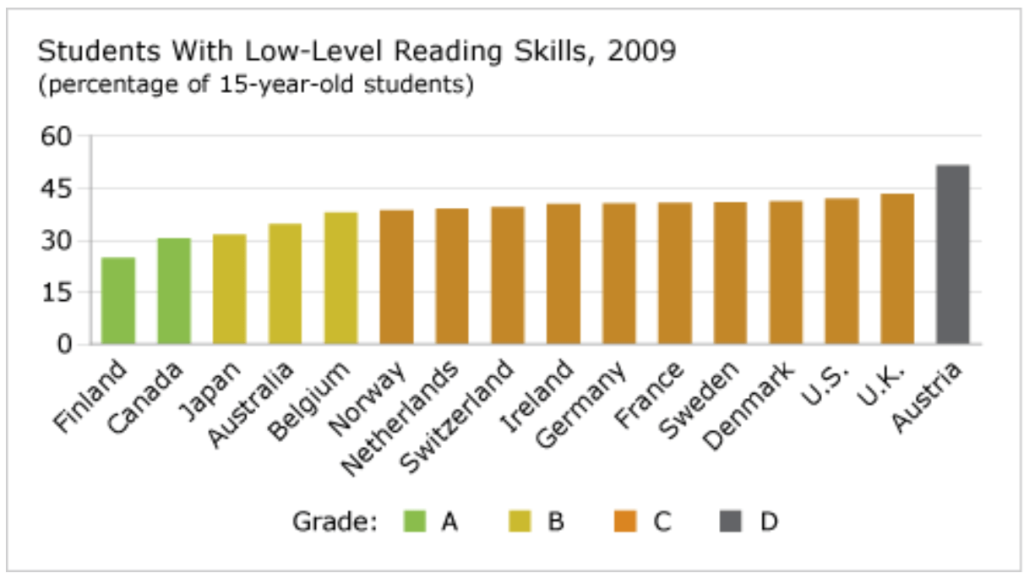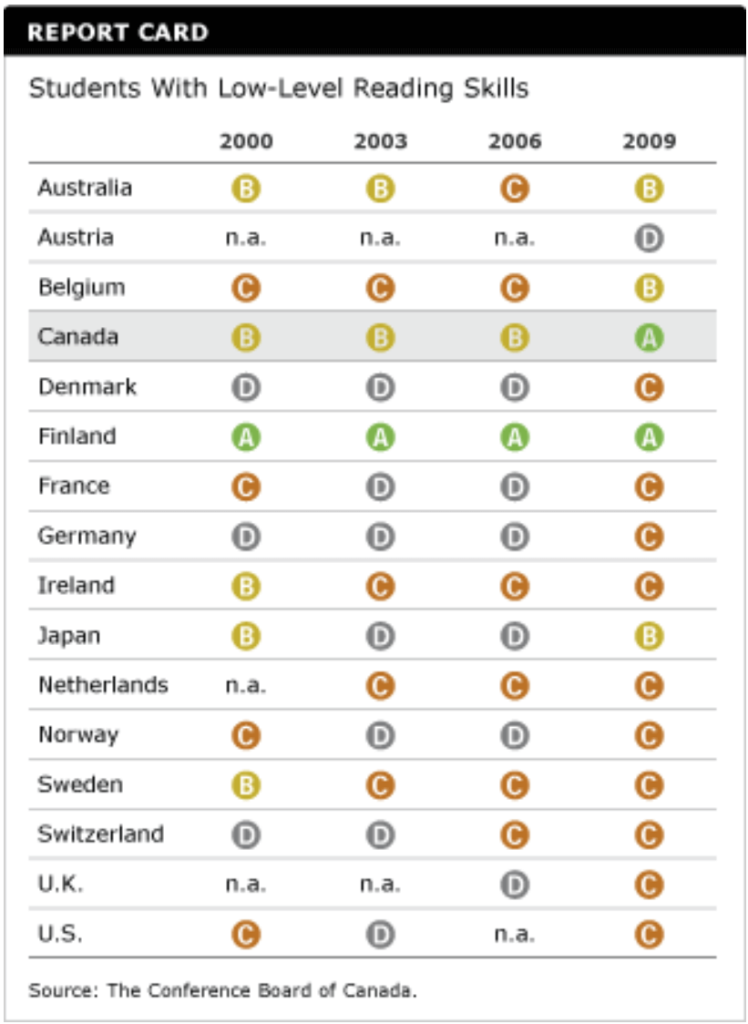Students with Low-Level Reading Skills
Key Messages
- Canada gets a “A” grade and ranks 2nd out of 16 peer countries.
- The proportion of Canadian students with low-level reading skills has increased since Canada first participated in the PISA reading section in 2000.
- Canada will have difficulty catching up to the leader, Finland.

Putting student reading skills in context
The Programme for International Student Assessment (PISA) is an international assessment of the skills and knowledge of 15 year olds, coordinated by the Organisation for Economic Co-operation and Development (OECD). It assesses whether students approaching the end of compulsory education have acquired the reading, math, and science skills that will help them to succeed in life.
A report on Canada’s results on the PISA tests highlights the importance of these skills:
The skills and knowledge that individuals bring to their jobs, to further studies, and to our society play an important role in determining our economic success and our overall quality of life. The shift to a knowledge-based economy driven by advances in information and communication technologies, reduced trade barriers and the globalization of markets has precipitated changes in the type of knowledge and skills that the present and future economy requires. This includes a rising demand for a strong set of foundation skills upon which further learning is built.1
What kind of reading skills does PISA test?
The reading skills that PISA measures are much broader than the basic ability to read. They include the ability to understand and use the information in a text in range of situations and for different purposes.
Since comparatively few young adults in OECD countries have not acquired technical reading skills, PISA does not seek to measure such things as the extent to which 15-year-old students are fluent readers or how well they spell or recognize words. In line with most contemporary views about reading literacy, PISA focuses on measuring the extent to which individuals are able to construct, expand and reflect on the meaning of what they have read in a wide range of texts common both within and beyond school.2
What are low-level reading skills?
PISA reading skills are measured on a continuum, with level 6 the highest and level 1 the lowest. There is no cut-off at which a person is said to either have or not have reading skills. However, students at level 2 are capable of completing only the basic reading tasks developed for PISA. The Statistics Canada report on Canada’s PISA results describes level 2 as “a baseline of proficiency at which students begin to demonstrate the required competencies to use reading for learning.”3 Scores at level 2 and below mean that students have not acquired the level of reading skills required to participate effectively and productively in life.
How do the low-level reading skills of Canadian students compare to those of Canada’s peers?
Just slightly over 30 per cent of Canadian student participants scored at level 2 or lower on the PISA reading assessment in 2009. This shows that most young Canadians have the basic reading skills required to participate in society. Canada is in second place on this indicator and achieves an “A”.
With an impressively low 25 per cent of Finnish students scoring low on the PISA assessment, Finland once again finds itself in first place among 16 peer countries and is the only other country to receive an “A”.
Austria, in last place, demonstrates how wide the gap can be between the best and the worst performers on this indicator. More than 51 per cent of Austrian students scored at level 2 or lower on the PISA reading literacy assessment in 2009.
Has Canada been able to decrease the proportion of students with low-level reading skills?
The OECD has conducted four PISA reading tests—in 2000, 2003, and 2006, and 2009.
In Canada, the proportion of students with low-level reading skills keeps going up. In 2000, the first year of testing, the proportion of students with low-level reading skills was 27.6 per cent. This share rose to 27.9 per cent in the second test in 2003, and again to 28.9 per cent in the third test in 2006, and yet again to 30.5 per cent in 2009.
Despite the rise in students with low-level reading skills in Canada, several other peer countries did worse, with the result that Canada’s grade improved to an “A” in 2009, up from a “B” in 2000, 2003, and 2006. Only two peer countries—Germany and Switzerland—managed to decrease their share of students with low-level reading skills.

Does PISA reading performance results predict future educational success?
Reducing the share of students who perform poorly in reading is important for both the students and society as a whole, since there are large economic and social costs associated with poor performance in school.4 Studies based on PISA data reveal that students with low-level reading skills were more likely to drop out of high school and have worse labour-market outcomes.5
Results from the Youth in Transition Survey, by Statistics Canada, show a strong association between reading proficiency and education attainment: students scoring below level 2 at age 15 face a much higher risk of dropping out of high school and not continuing to university.6
Footnotes
1 Tamara Knighton, Pierre Brochu, and Tomasz Gluszynski, Measuring Up: Canadian Results of the OECD PISA Study (Ottawa: Statistics Canada, 2010), 9.
2 OECD, Learning for Tomorrow’s World: First Results from PISA 2003 (Paris: OECD, 2004), 279.
3 Tamara Knighton, Pierre Brochu, and Tomasz Gluszynski, Measuring Up: Canadian Results of the OECD PISA Study (Ottawa: Statistics Canada, 2010), 25.
4 OECD, PISA 2009 Results: Learning Trends. Volume 5: Changes in Student Performance Since 2000 (Paris: OECD, 2010), 42.
5 OECD, PISA 2009 Results: Learning Trends. Volume 5: Changes in Student Performance Since 2000 (Paris: OECD, 2010), 42.
6 OECD, Pathways to Success: How Knowledge and Skills at Age 15 Shape Future Lives in Canada (Paris: OECD, 2010).

